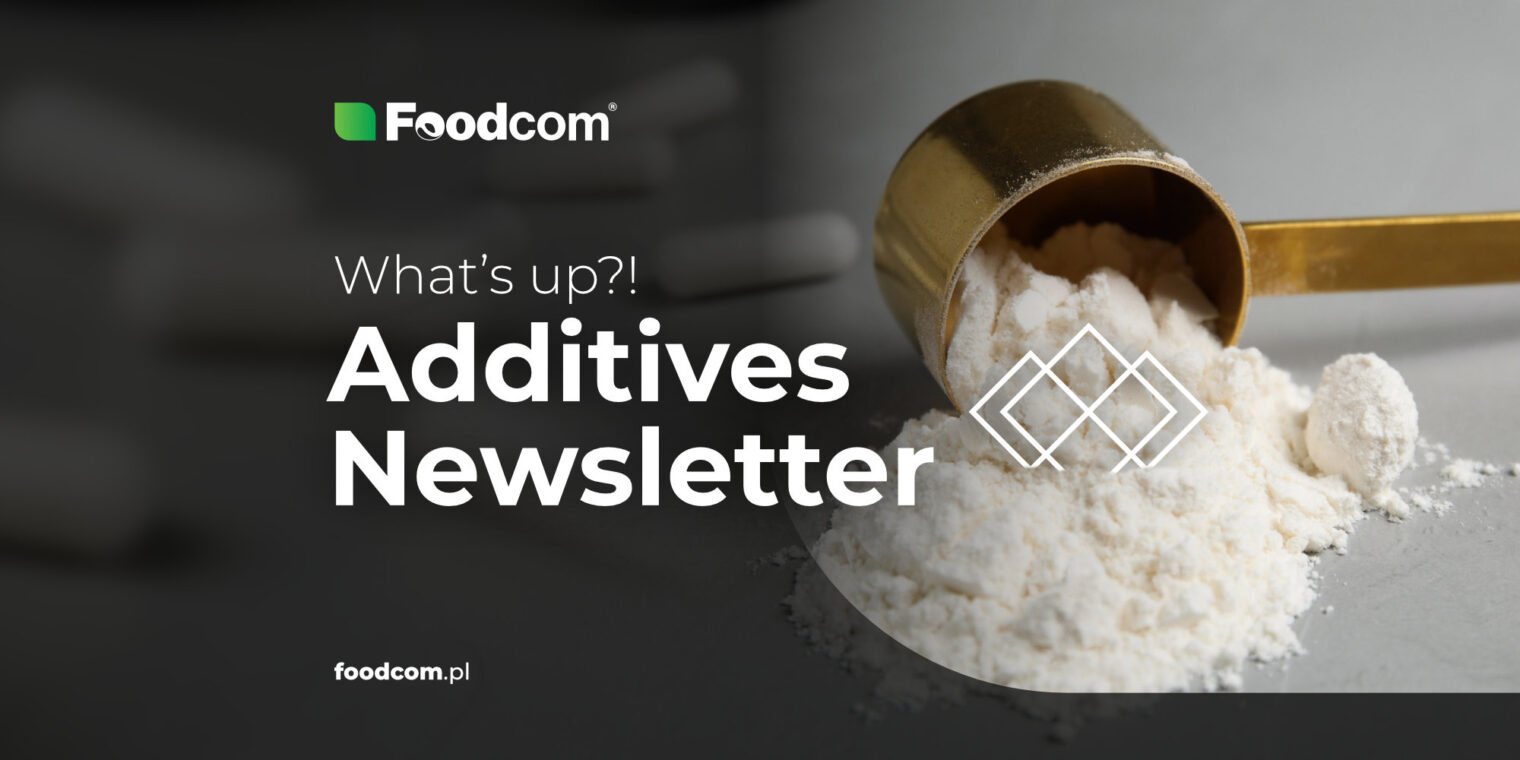The summer season is definitely in full swing and has a significant impact on the additives market. Tourists and their consumption are most responsible for the growth of production, which means higher demand for all food additives. What is more, we are also seeing increased interest in additives for feed production.
What you really need to know is that we have some new products on board. The first newbie is Peracetic Acid 15%, which is commonly used to wash fruit before freezing. The second new one is a preservative called Sorbic Acid (E200), an incredibly effective antimicrobial agent used in foods and beverages to prevent the growth of mold, yeast, and fungi.
Below, you can read more about recent changes in demand and supply for individual additives. Later in the newsletter, you’ll also find important news about the robot code of conduct (finally, someone has stopped them), ambitious environmental goals, adding surprising ingredients to feed, and, once again, why the future is now (old man). You probably already know that we have much more prepared, so be sure to read to the end!
Lysine HCl
We are seeing a lot of demand for this commodity, especially from chicken farmers. A new producer has entered the scene, so it is quite possible that the price will fall as a result.
Citric Acid
Prices are dropping. We are approaching the end of the period of intensive production of this commodity. We hear that there will still be one large batch of Citric Acid on the market, and that’s it.
Xanthan Gum
A few weeks ago, demand was high due to the peak season for Xanthan Gum, and many predicted a further increase. Last week brought some changes: Chinese manufacturers have begun to lower prices due to falling demand.
L-Threonine
As of recently, Threonine continues to be the most popular amino acid. Due to reduced production, there is a good chance that it will continue to be in demand and the price will rise. Undoubtedly, this is a hot topic that many (if not literally everyone in the additives sector) are talking about right now.
Europe
Britain implements a code of conduct for… Robots.
A code of conduct for crop robots has been published in Great Britain. The aim is to promote the safe use of tools that can help farmers operate more sustainably, address labor shortages and respond to global demand for more intensive crop management. The creation of the code will primarily benefit farmers, gardeners, government agencies and autonomous farm equipment manufacturers. We know we ask this question a lot, but… Has an app already been developed to allow humans to use robots in accordance with the code?
Spain sets increasingly ambitious targets for green hydrogen and biogas.
Spain plans to double its targets for biogas and green hydrogen production by 2030. This is to be part of a strategy to expand the country’s energy and climate goals. The new plan includes higher targets for solar and wind energy, as well as energy storage and other initiatives. Implementing the current plan will require investments of about 294 billion euros, 85% of which will come from the private sector. An additional effect of the targets is expected to be the creation of up to half a million new jobs.
Under pressure from industry, an emergency rule was submitted in England and Wales.
The rule is for the approval of major cobalt salts for use in livestock feed in the two countries of the United Kingdom. A letter from the Agriculture Minister confirmed that statutory instruments (SIs) for urgent approval of the four cobalt additives have now been tabled in Parliament. The SIs have been harmonized to take effect across the UK at the beginning of July, ensuring an uninterrupted supply of cobalt feed additives to the market.
The Americas
American farmers are trying a new approach.
Limited supplies of grass and hay are forcing ranchers to look for alternative feed options. A University of Missouri Extension scientist recently discovered that one interesting option is to add ammonia to wheat straw. Adding anhydrous ammonia to wheat straw should improve its nutritional value and make it a particularly valuable alternative, especially in times of drought. Has anyone asked the cattle how they like it and can share their impressions?
USDA approves lab-raised chicken.
Two start-up companies operating in the United States have received approval from the USDA to sell the country’s first products made from laboratory-bred chicken. They have been deemed safe for human consumption. Analysts predict the lab-raised meat industry will be worth as much as 25 billion in the future. So what, lab-grown chicken for everyone for dinner tonight?
Prices for hydrochloric acid in the United States are falling in the face of sluggish oil and gas drilling.
The price of hydrochloric acid fell 7% in the U.S. market in May 2023. The factors that contributed to the changes in hydrochloric acid prices were the decline in demand from the oil and gas drilling industry and the slowdown in the steel industry. In the other downstream sector, i.e. the steel industry, demand for hydrochloric acid as a pickling agent and for removing surface oxidation in steel applications has also fallen dramatically.
Asia & Oceania
Indonesia will begin producing bioethanol from sugarcane and cassava.
Indonesia’s state-owned energy company PT Pertamina plans to start producing bioethanol from sugarcane and cassava this year. The company has also already begun producing green hydrogen from geothermal energy. The new activities are part of a plan to optimize the use of available raw materials: sugar cane and cassava to produce ethanol and palm oil to produce biodiesel.
New Zealand is fighting with methane production in agriculture.
The New Zealand government has announced the construction of a new research center to monitor and measure methane emissions from cattle. This is expected to be one of many projects the country will develop in the near future to promote more sustainable development and environmentally friendly agriculture. The cattle emissions research project is expected to cost $17.5 million, with most of the funding coming from the government. The center is expected to be built in a little more than a year. The new project also aims to show how seriously New Zealand is taking climate change.
Japan stopped poultry imports from Brazil.
Japan has decided to suspend purchases of poultry from Brazil after another outbreak of highly pathogenic avian influenza was detected at a non-commercial farm. The decision was made after it became known that the first case of bird flu had been recorded in non-wild birds. The Brazilian side says the decision is contrary to World Organization for Animal Health guidelines because it was not agreed upon in a health protocol between the two sides. It is worth noting that the first cases of avian influenza in wild birds were detected in Brazil on May 15 and 50 outbreaks have been detected since then. At the same time, industrial breeding continues for now without a single case.







